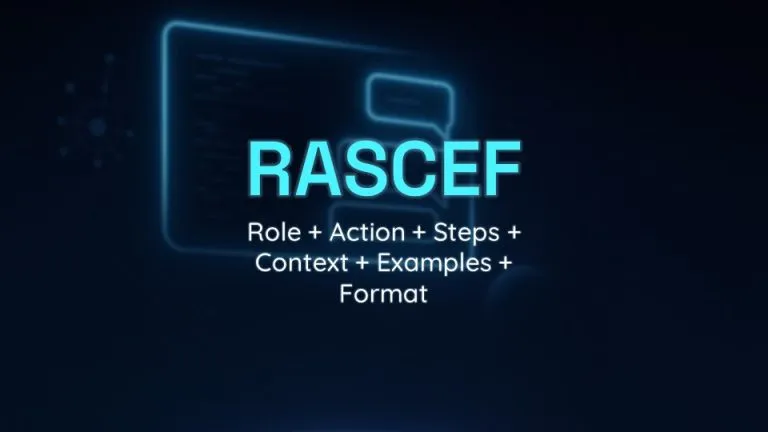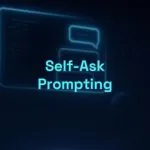RASCEF Framework: Role, Action, Steps, Context, Examples, Format

When a task requires total clarity about the process, the RASCEF framework is the right choice. With six well-defined components, it helps organize your prompt in a structured and direct way — ideal for obtaining detailed responses with step-by-step instructions and practical examples.
If you’re looking for clear guidance, well-structured plans, or complex instructions, RASCEF enables the AI to deliver all that with logic and precision. Let’s discover how to apply it.
What is the RASCEF Framework?
The RASCEF framework is a robust structure that combines context with action, offering a complete roadmap for the AI to follow. Its six components ensure your request is well defined and delivered in the format you need. Let’s break down each part and see when it’s the best fit.
Structure Components
- Role: Defines who the AI should act as, like “marketing consultant” or “fitness instructor.” This adjusts the tone and level of expertise.
- Action: Specifies what you want the AI to do, such as “develop a plan” or “explain a concept.”
- Steps: Details the specific stages the AI should follow, like “analyze, plan, execute.”
- Context: Provides the background or scenario, helping the AI understand the “where” and “why.”
- Examples: Gives references of what you expect, like “include X” or “follow Y’s style.”
- Format: Defines how the response should be presented, such as “numbered list” or “table.”
These elements create a prompt that leaves little room for doubt — delivering practical, well-organized results.
When to Use It?
RASCEF is perfect when you need a structured and detailed response. Use it if:
- You want a plan or guide with clear, applicable steps.
- You need something tailored to a specific context, such as a niche or audience.
- You’re looking for a specific format to make the response easier to use.
For example:
“As a [Role], do [Action] by following [Steps]. Consider [Context], using [Examples], in [Format].”
Practical Examples of RASCEF in Action
To show the power of RASCEF, here are three examples applying the framework to real-world situations. See how it organizes ideas and delivers useful solutions.
Example 1: Launch Plan for a Podcast
Context: You want to start a podcast about technology and need an initial roadmap.
As a digital content producer (Role), create a plan to launch a podcast (Action) by following these steps: 1) Choose the theme, 2) Define the audience, 3) Plan the first episodes (Steps). Consider that I’m a beginner with a limited budget (Context), using examples like short episodes or simple interviews (Examples). Present it in a numbered list with brief descriptions (Format).Why it works: The Role brings expertise, the Action defines the goal, and the Steps structure the process. The Context adapts the solution, the Examples guide the content, and the Format organizes the delivery.
Example 2: Productivity Guide for Remote Work
Context: You work from home and want to optimize your day.
As a productivity coach (Role), create a guide to improve efficiency in remote work (Action) by following these steps: 1) Organize the workspace, 2) Set schedules, 3) Reduce distractions (Steps). Consider a professional who uses multiple digital tools (Context), with examples like time-blocking or focus apps (Examples). Deliver in short sections with headings (Format).Why it works: The Role gives authority, the Action defines the task, and the Steps detail the path. The Context personalizes it, the Examples inspire, and the Format eases readability.
Example 3: Interactive Online Event Script
Context: An organizer needs a dynamic plan for a webinar on innovation.
As an educational events producer (Role), create a script for a 1-hour online event on public sector innovation (Action), with the steps: 1) Opening and speaker introductions, 2) Case study presentations, 3) Q&A, 4) Closing with a call to action (Steps). Consider that the audience includes public managers and institutional innovation agents (Context), using examples like “GovTech Talks” and “InovaGov Summit” (Examples). Present in script format with estimated time per section and notes (Format).Why it works: It aligns the content with the event duration, audience, and objectives — and facilitates direct use of the material by the organizer.
Tips to Make the Most of RASCEF
RASCEF is flexible and can be shaped to fit your specific goals. Here are some suggestions to personalize it and get the best results.
Customize for Your Goal
- Role: Choose a role that fits the perspective. “Finance expert” is technical, “experienced friend” is more casual.
- Action: Be clear in what you want. “Give tips” is vague, “create a detailed plan” is precise.
- Steps: Adjust the quantity and focus. Use 3 steps for something simple, 5+ for more complex needs.
- Context: Add relevant details. “For students” changes the approach compared to “for CEOs.”
- Examples: Use references that guide the tone. “Like a checklist” or “tutorial-style” gives direction.
- Format: Choose strategically. Lists are practical, paragraphs explain, tables compare.
Quick Example:
“As a UX designer (Role), develop a process to test a health app (Action) in: 1) Identify users, 2) Create tests, 3) Analyze feedback (Steps). Consider an app for elderly users (Context), using examples like simple questions or prototypes (Examples), in a table with one column per step (Format).”
Start Using RASCEF Today
The RASCEF – Role, Action, Steps, Context, Examples, Format framework is your go-to tool for turning ideas into clear, executable plans with the help of AI. It combines context, action, and structure — ensuring your interactions with LLMs are practical and well directed. Whether for personal or professional projects, this structure delivers results you can apply immediately.
🎯 Quick Summary:
RASCEF defines who is acting (Role), what to do (Action), how to do it (Steps), the setting (Context), references (Examples), and how to deliver it (Format).
🔗 Want to explore more frameworks like this?
Check out the Practical Guide to Prompt Techniques, Frameworks, and Formulas for LLMs, with dozens of detailed and applicable structures for different contexts and goals, plus techniques and prompt engineering tips.
📘 Bonus tip:
Download the free eBook “Prompt Engineering Unveiled”, featuring easy explanations, practical examples, and strategies ranging from basic to advanced to master communication with AI.



